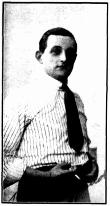English-born singer (baritone), songwriter, teacher (singing), entertainer, radio host, stage and musical director, character actor, film prologue specialist.
Born at Wood Green, London, possibly in the mid to late-1880s, Fred Monument intended pursuing a business career after he completed his schooling. A passion for singing led to him being trained by Bernard Flanders and in 1906 he won a gold medal at the East London Music Festival. After making the decision to become a professional singer Monument reportedly found initial success through appearances at the Queen's Hall under the direction of Henry J. Wood (later Sir Henry J. Wood). In 1910 he accepted an engagement with Herbert Fordyce's Patchwork Musical Company as principal baritone and the following year moved into variety entertainment as a member of Roland Henry's Comedy Entertainers.1912 saw him win the Grand Prix at the London Musical Festival and visit the USA. He then decided to try his luck in Australia. Within days of his arrival he secured an engagement with Edward Branscombe that involved touring Australia with the entrepreneur's Green Dandies troupe for two years beginning November 1912.
Shortly before the Dandies opened for a season at St Kilda, Melbourne October 1914, Monument left to take up residence in Brisbane for a year. During his time in the Queensland capital he became involved with such organisations as the Brisbane Musical Union, Queensland Irish Association, Brisbane Liedertafel, and Royal Society of St George. He also performed in, and sometimes helped produce, charity concerts and patriotic fundraising events. One of the highlights of 1915 was his starring role in the world premiere production of The Stenographer Girl (1915). The locally-written comic opera, which he also directed, was put on by the Brisbane Patriotic Comic Opera Company at the Tivoli Theatre (31 July - 6 August). In October 1915 Monument left Brisbane to rejoin the Green Dandies in Sydney.
After severing his association with Edward Branscombe in mid-1917 Monument initially found employment with J. and N. Tait (1917-1918) and Harry Rickards' Tivoli Theatres (1918). As a member of the Tait's musical comedy company he appeared in such productions as The White Chrysanthemum, Very Good Eddie, Aladdin (1917) and Jack and Jill (1918). His time on the Tivoli circuit (Sydney and Melbourne only) included the revues Honi Soit and Time Please. The 1910s also saw Monument establish his reputation as songwriter. One of his biggest original song hits of the decade was 'Wattle-Blossom Time in Australia.' It featured in the Fullers' 1916 pantomime, The Bunyip, Or, The Enchantment of Fairy Princess Wattle Blossom.
In 1919 Monument left Australia to tour the East with Athol Tier's company. Known destinations were Java and the Straits Settlement. Late the following year, after concluding seasons in Perth and Fremantle, Monument co-founded the Futurists Costume Comedy Company with ex-Royal Strollers comedians Cyril Northcote and G.W. Desmond. The eight-member ensemble then spent some three years touring overseas. Newspaper reports indicate that they travelled extensively through Java, the Federated Malay States, Ceylon, Burma, India, Afghanistan, Uganda, Rhodesia, and South Africa among other countries.
Upon his return to Australia in late-1923 Monument worked in vaudeville and as a between-films entertainer before securing a role in Ada Reeve's Aladdin pantomime. A tour of Australia and New Zealand (1923-1924) with Reeve's company was followed by a New Zealand engagement with George Story's Revue Company. By early 1925 Monument was back in Brisbane, the city which then became his permanent home. Over the next five years he was largely associated with the Cremorne Theatre, appearing with such companies as the Topics of 1925 and the Crackers.
During the final years of the silent film era he also established his reputation as a prologue specialist in Brisbane, presenting introductory and/or explanatory segments, either alone or in company with other actors, to such films as Don Juan and Mare Nostrum. His career in Brisbane during the 1930s and 1940s included a final professional engagement - with Graham Mitchell's Serenaders (1935) - and appearances at numerous community events, concerts, smoke nights, as well as work at various city and suburban cinemas as a between-films entertainer.
Although settled in Brisbane with his family from 1925 onwards, Monument occasionally left the city to work elsewhere for brief periods. In late-1927, for example, he accepted an engagement in Sydney with Clay's Theatres. The following year he toured North Queensland with the Billy Cass Revue Company (aka The Cameos) and reappeared in Sydney at the new Empire Theatre (along with Fred Bluett), followed by a season at the Garden Theatre, Darlinghurst (for Norman Barrington and Leonard Stephens).
Monument is believed to have made his radio debut on 21 March 1926 with 4QG. The broadcast was an attempt to connect with American radio stations. In 1929 he established a highly popular 'argumentative' radio partnership with comedian Bert Harrow. Monument became an announcer for 4BK when it began broadcasting in October 1930 and moved to the newly-formed Australian Broadcasting Commission in 1933, remaining with its Brisbane station (4QG) as an announcer until at least the end of 1935. His later radio commitments included acting and roviding sound effects for such plays as The Unlucky Lady (1942), Cracked Ice (1946), and Finish Under Fire (1946).
Monument also recorded a number of his own songs for the Parlophone label, notably "Wandering On," "The Prisoner's Child" (1927) and "Hustling Hinkler" (1928). These were all given national airplay during the late-1920s.
Although he retired from the professional stage in 1936, Monument continued to be active as a community entertainer/emcee and radio actor/performer/soundman (mostly for 4QR) up until the late-1940s. He also reportedly worked as a traveller for Edward Dunlop at some stage.
[Source: Australian Variety Theatre Archive. Sighted 23/10/2017]
 4093767233547708957.jpg
4093767233547708957.jpg

